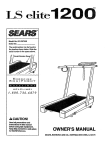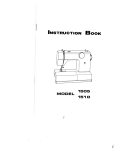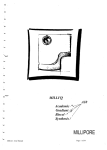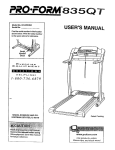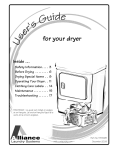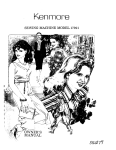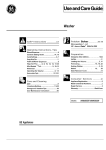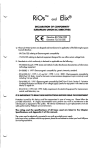Download White 2221 Instruction manual
Transcript
mm 1 rn.. r m 0 POLARIZED PLUG CAUTION To reduce the risk of electric shock, this appliance has a polarized plug (one blade is wider than the other). This plug will fit in a polarized outlet only one way. If the plug does not fit fully in the outlet, reverse the plug. If it still does not fit, contact a qualified electrician to install the proper outlet. Do not change the plug in any way. WHITE SEWING MACHINE Record in space provided below the Serial No. and Model No. of this appliance. The Serial No. is located side of arm The Model No. is located side of arm. Serial No. Model No. 2221 Retain these numbers for future reference. PORTANT SAFETY INSTRUcTIONS When using an eiectñcal appliance, basic safety precautions should always be followed, including the following: Read all instructions before using (this appliance) DANGER —To reduce the risk of electric shock: — An appliance should never be left unattended when plugged in. Always unplug this appliance from the electric outlet immediately after using and before cleaning. WARNING ——To reduce the risk of burns, fire, electric shock, or injury to persons: 1. 2. 3. 4. 5. 6. 7. 8. 9. Do not allow to be used as a toy. Close attention is necessary when this appliance is used by or near children. Use this appliance only for fts intended use as described in this manuaL Use only attachments recommended by the manufacturer as contained in this manual. Never operate this appliance ii it has a damaged cord or plug, if it is not working property, If It has been dropped or damaged, or dropped into water. Return the appliance to the nearest authorized dealer or service center for examination, repair, electrical or mechanical adjustment. Never operate the appliance with any air openings blocked, Keep ventilation open ings of the sewing machine and foot controller free from the accumulation of lint, dust, and loose cloth. Never drop or insert any object into any opening. Do not use outdoors. Do not operate where aerosol (spray) products are being used or where oxygen is being administered. To disconnect, turn all controls to the off (“0”) position, then remove plug from outlet. Do not unplug by pulling on cord. To unplug, grasp the plug, not the cord. DANGER 1. Always unplug before relamping. Replace bulb with same type rated 15 watts. 2. Do not reach for an appliance that has fallen into water. Unplug immediately. 3. Do not place or store appliance where it can fall or be pulled into a tub or agik. Do not place in or drop into water or other liquid. 4. WARNING 1. Keep fingers away from all moving parts. Special care is required around the sewing machine needle. Always use the proper needle, plate. The wrong plate can cause the needle to break. Do not use bent needles. Do not pull or push fabric while stitching. It may deflect the needle causing it to break. Switch the sewing machine off ( ‘0”) when making any adjustments in the needle area, such as threading needle, changing needle, threading bobbin, or changing presser foot, etc. Always unplug sewing machine from the electrical outlet when removing covers, lubricating, or when making any other user servicing adjustments mentioned in the instruction manual. Never operate on a soft surface such as a bed or couch where the air openings may be blocked. 2. 3. 4. 5. 6. 7. • SAVE THESE INSTRUCTIONS 1. NAME AND FUNCTION OF PARTS 2. ACCESSORIES 3. BEFORE SEWING A. Converting machine B. Connecting Foot Controller and Power Cord C. Changing Needle D. Changing Foot E. Winding Bobbin F. Lower Threading G. Upper Threading H. Drawing up Lower Thread 4. FUNCTION OF DEVICE A. Pattern Selector B. Zigzag Width Dial C. Stitch length Dial D. Adjuster 2. Reverse Sewing Button F. Needle Position Control G. Drop Feed Lever H. Foot Pressure Regulator I. Double Presser Foot Lifter 5. PATTERN SETTING 6. FABRIC, THREAD AND NEEDLE TABLE 7. STRAIGHT SEWING A. Trial Sewin B. Thread Tension Adjustment 8. ZIGZAG SEWING 9. ELASTIC SEWING 10. MAKING BUTTONHOLES 11. OVERCASTING 12. STRETCH STITCHING 13. OVERLOCKING 14. BLIND HEM STITCHING 15. MENDING 16. ZIPPER SEWING 17. ROLL HEMMING 18. ATTACHING ELASTIC 19. LAPPED SEAM SEWING 20. QUILTING 21. APPLIQUE WORK 22. EMBROIDERY 23. TWIN NEEDLE SEWING 24. PIN TUCKING 25. MAINTENANCE A. Cleaning Feed Dog And Hook B. Oiling Under Top Cover And Face Cover C. Changing Light Bulb 26. TROUBLE CHART .1.2 3 4-10 4 5 5 6 7 8 9 10 11-12 11 11 11 11 11 12 12 12 12 13 14 15 15 16 17 18 19-21 22 23 24 25 26 27 28 29 30 30 31 32 33 34 35-33 35-36 37 38 39-40 •1 / - r\) N 0) -A —A 01 C.) ÂME AND FUNCTION OF PARTS hread Guide: To guide thread for bobbin winding. p Thread Guide: ro lead upper thread. ke-Up Lever: Safety-designed take-up lever for easier threading. Thread to be led from right to left. Thz cad Guide: To lead upper thread from right to left. Needle-Bar Thread Guide: To lead upper thread into the left guide for regular sewing. dresser Foot Thumb Screw: To fasten presser foot holder. Needle Plate: For smooth feeding to aid sewing, also marked for seam guides. Plastic Plate: You can see the quantity of lower thread. Drop Feed Lever: To lower feed dog for darning and embroidering, etc. Extension Table With Accessory Box: To convert the machine style into flat-bed use. To store the accessories. 11. Spool Pin (Retractable): To mount spool of thread. Retracts when not in use. To sew with twin needles. 12. Pattern Selector: To select the stitch pattern, turns both ways. 13. Zigzag Width Dial: To adjust zigzag width. 14. Stitch Length Dial: To adjust stitch length. 15. Reverse Button: To be pushed for reverse sewing, hold in for continuous reverse sewing. 16. Adjuster: To adjust buttonhole stitches balance and stretch stitch appearance. Bobbin Winder Spindle: To wind lower thread by pushing spindle to nght. Bobbin Winding Stopper: To stop bobbin winding when bobbin has been filled by thread. Handwheel: Always turn it towards you. When bobbin winder spindle is in right position ,hand wheel is disengaged with needle drive mechanism, even if pressing the foot con troller, the machine needle should not move. Power And Light Switch: To turn machine on and to turn on sewing light at the same time. Electrical Receptacle For Foot Controller: To plug in foot controller and obtain power supply. Upper Thread Tension Dial: To adjust upper thread tension according to material and thread used. Pressure Regulator: To change pressure of presser foot. Handle: To carry machine. Folds away when not in use. 25. Presser Foot Lifter: To raise foot. With 2-step lifter, thicker fabrics can be easily fed under foot. 26. Needle Clamp Screw: For needle replacement. 27. Snap-On Presser Foot: Easily changeable foot. 28. Feed Dog: To feed materials by its teeth. —2— The accessories come with your machine as stan dard equipment and are stored in extension table. --3— A. Converting Machine For flat-bed use For free arm use Slide to left to take it off, and the machine can be used as a free-arm model. A free-arm is convenient to sew or embroilder; trousers, sleeves, cuffs of T-shirts, blouses, etc. Do viceversa of above steps to attach extension table. To open lid of accessory box, push it open, as illustrated. —4--- Connecting Foot Controller and Power Cord . Connect foot controller and power cord. Before plugging in, be sure voltage of machine conforms to your electrical power supply. Alwais unplug machine when not in use. Be careful not to drop foot controller. Switch on power to turn on machine and sewing light simultaneously. The more you press foot controlle the faster the machine runs. * Specifications vary from country to country. C. Changing Needle (1) Bring needle to highest position by turning handwheel towards you. (2) Loosen needle clamp screw and remove needle. (3) With flat side away from you, insert new needle as far as it will go. (4) Push needle until it reaches stopper ® and tighten needle clamp screw firmly. Use Ball-point Needle for stretch fabrics. Needles for industrial sewing machine can not be used. —5— • :: : •-—— •— • —--—-.——.- .•---•• ——••--. :. .. . - • ,--••-•- ‘S Do not use bent or blunt needles. Using defective or worn needles not only causes-stitch skipping, breakage of needles or snapping of thread; it also can damage hook and needle plate. Ni D. Changing Foot Raise presser foot lifter. Bring needle to highest position. (1) Push button of holder towards you and foot will come off. (2) Position a new foot with the pin right under the groove of the holder. (3) Lower presser foot lifter so that holder catches a presser foot. If holder does not catch a presser foot perfectly, press the lifter slightly. I —6— I E. Winding Bobbin (1) Pull up spool pin. (2) Put spool on spool pin. Draw thread from spool pin through thread guide as following number ©and©. (3) Wind thread clockwise around bobbin several times. (4) Push down bobbin on spindle as far as it will go. (5) Push bobbin towards handwheel and press down foot controller. 4 Do not put your fingers near needle as needle may move a little when starting to wind bobbin. Never push spindle towards handwheel while sewing. (6) Machine stops automatically when winding is finished. Return spindle by pushing it in direction of arrow. Remove wound bobbin. —7— / F. Lower Threading / Removing bobbin Slide plastic plate towards you and take out bob bin with your finger or bobbin extractor attached to opposite end of cleaning brush. Inserting bobbin (1) Insert bobbin into bobbin case with thread end in direction of arrow. (2) After pulling end of thread in direction of arrow of bobbin case. hook it on right cut-out (3) While pulling thread, it will be inserted automat ically between bobbin case and spring. Pull thread to turn bobbin a few times. (4) Move thread to left and hook thread on left of bobbin case and pull it up towards cut-out needle. } (5) Pull out thread for about 15cm (6) and ciose plastic plate. I- J —8—- IF IF Raise presser foot. Set take..up lever to highest position by turning handwheel towards you. Thread by following steps: (1) Lead thread from spool, hook it onto guide and pass it between guide D and guide . (2) Draw thread to the front and into either slit of thread tension unit © making sure thread is firmly between both tension discs. N , (3) Hook thread onto guide insert into spring. ® and pull it up to \ (4) Hook thread onto take up Lever it is through hole. © making sure N it is easier to check threading if face plate is open. (5) Pull thread downwards, thread guide ® and pull it to the left. (6) Pull thread through left guide © and thread needle ® from front to back, leaving an end of about 15cm. (6”) —9— 1 j. Lower 4rnead Holding end of upper thread with left hand, and keeping it black, turn handwheel towards you. When needle goes down and returns, pull upper thread lightly and lower thread will come out and up in a loop. L / Do not pull upper thread too hard as this may bend needle. 0/ Place both upper and lower threads unde r foot on the left side. 4. FUNCTION OF DEVICES I } A. Pattern Selector ® Set pattern indicator to the required stitch pat tern by turning selector. Do not forcibly turn to the left at” “nor to the right at” The end of pattern dial. 0. Reverse Sewing Button © Press reverse sewing button and machine will sew backwards for as long as button is depressed. “. E. Adjuster ® Always make sure the needle is in the highest position when operating the dial. Finely adjusts stretch stitch appearance and stitch density on right and left side balance of buttonhole. B. Zigzag Width Dial © Set dial at required number. Larger the num ber, wider the stitch. C. Stitch Length Dial © Set dial according to stitch size required. To obtain the right stitch length and width for each pattern, set the dial within the color band corresponding to the pattern selected. —11— F. Needle Position Control D When pattern 7 is selected and the manual stitch width dial is activated, you can move the needle between center and left needle positions. 4 / Use left position for fine fabrics as not to pull material down into needle plate. Use gene,i purpose foot. G. Drop Feed Lever ® —AA— Push lever towards you. Engage feed ing for normal sewing. LA Push lever away from you to lower feed dog for button sewing, embroidery, etc. H. Foot Pressure Regulator ® Normal sewing: Usually for straight sewing or zigzag sewing, pressure pin ® should be main tained in the lower position. Thin or delicate fabric sewing: Because lighter pressure is desirable for perfect sewing of tine silk or thin fabric, pressure button should be adjusted in the middle or center. Loosen pressure with outer ring and then push pressure pin ® half way towards the bottom. Darning and embroidering: To be able to move fabric freely in case of darning, mending, basting and embroidering. loosen pressure pin by pushing outer ring . I. Double Presser Foot Lifter (J) Presser. foot lifter can be lifted up one more step to obtain wider gap for placing thick materials, but tons, etc. t 1’ —12— z SELECTOR WIDTH LENGTH 3.5—6.5 0.3—i g ] 1 ---4 5 1 6 f/AV/A\V/A\\ 3.5—6.5 7 0 8 0 A 9 I ‘ A ‘‘ ‘i A V 6.5 0.5 —4 4 4 3.5—6.5 0.5—i 10 1 .5 —4 1 —2 1 1 3.5—6.5 1 —2 12 3.5—6.5 0.5—i 13 1 .5 —4 14 1 ,..IIIIIl\ i —2 3.5—6.5 0.5—i 3.5—6.5 4 3.5—6.5 4 17 3.5 —6.5 4 18 3.5 —6.5 4 is 16 /\AJ\J\ —13— FOOT NEEDLE THREAD FABRIC Cotton Covered Polyester, Silk, Nylon European 705 U.S. Size 15x1 Point Style Cotton Mercerized Cotton 70 60 Silk Nylon 65-70 9 Regular ;H::R: cuse Crepe, ivin, Organdy, Taffeta 50-70 60 Silk Nylon 65-70 9 I Regular i(HT-WElGHT; Crepe, •iool, Brocade, Velvet 30 50 Silk 75-80 11 EDlUM; Wool, Silk, men, Velvetten, Cotton, aille, Terrycloth 30 50 Silk 80-90 11-14 Regular HEAVY: Denim, Duck, 30 Heavy Duty CC. Poly. 100 16 Regular 30 Heavy Duty CC. Poly. 120 19 Regular 50-70 60 Silk Nylon 70 9 Light Silk 70-80 European REMARKS -. ‘ERY SHEER: Lace, e. Chiffon, Net I ailcloth EXTRA HEAVY; JDholstery, Canvas, \wning KN ITS] .IGHT-WEIGHT; Tricot cwer net v1EDlUM-WElGH]’ 30 50 Jersey, Double Knit, ower Net -IEAVY-WEIGHT; Double <nit, Power Net 30 50 points Regular Ball 9-10 Light to Nylon Medium CC. Poly. Ball Silk Nylon 80-90 11-14 C.C. Poly. :AKEFURS, VELOURS I Medium To Heavy Ball 30 Heavy Duty C.C. Poly. 90-100 14-16 Ball or Sharp /INYLS FILMS 30 50 C.C. Poly. 90 14 Wedge .JGHT TO 1EIGHT 30 50 CC. Poly. 90-100 14-16 Wedge 30 Heavy Duty C.C. Poly. 100-110 16-18 Wedge 100-110 16-18 Regular 65-80 9-11 Regular LEATHER] - - MEDIUM- -IEAVY LEATHER DECORATIVE TOUCHES] Silk twist 0P STITCHING IACHINE EMBROIDERY Size 50-70 —14— Loosen upper tension one or two 7. STRAIGHT SEWING Set machine as shown. \- A. Trial Sewing Place fabric under foot. Position needle at starting point and lower foot. Leave an end of thread about 10-15cm (6 inch). \ To reinforce seam at beginning, sew in reverse to edge of fabric by pushing reverse button. Press reverse button as far as It will go. Release reverse button and start sewing, guiding fabric by hand as it is fed. Never pull too hard on material. —15——---—-------- ‘S” Draw fabric to left when sewing is finished. Cut thxeads by using thread cutter behind presser bar. n L z1 ® © B. Thread Tension Adjustment Upper tension Test stitch performance on a scrap of material you are going to use. With correct tension c upper and lower threads tension is equal and strong enough to lock both threads in center. If upper tension is too tight (loose), upper (lower) thread lies straight along upper (lower) surface of fabric Correct by turning tension dial. TØ Lower tension (1) With plastic plate closed, insert small driver into front hole and locate righthand adjusting screw. (2)turn adjusting screw clockwise if lower thread is too loose and counter-clockwise (. if it is too tight. a —16— cZi ,zWNG Set machine as shown. 7- thread-tension for zigzag stitching I- Better-looking zigzag stitching requires less upper tension than straight stitching. Loosen upper ten sion slightly. wrong side For thin fabric or any fabric easy to be wrinkled place a piece of paper underneath which will give neater finish. —17— —-“---—--— ——: right side 9. ELASTIC SEWING Use ball point needle to get better stitch performance. Use regular needle NO. 9-11 if not using ball point needle. Reverse straight stitch Use reverse straight stitch when seaming knits, jer seys and other elastic materials. Be careful when using straight stretch stitch be cause it is difficult to remove threads if you make a mistake. Small zigzag stitch Use small zigzag stitch especially for thin elastic materials N Multiple zigzag stitch Use multiple zigzag stitch for very elastic materi als such as bathing suits or lady’s underwear. Loosen pressure of presser root for very elas tlc materials. -I —18— Always make a test buttonhole in a piece of material you are working with and check satin stitch spac ing. Use slightly loose tension on top for neater finsb, buttonhole twist thread is recommended. 4 O3cm(118) f. Det9rmining length (Not for stretch fabrics) and thickness of button Measure diameter and add 0.3cm (1/8”) for bar tack. Mark buttonhole size on material. ‘ (For stretch fabrics) Make it as same size as diameter less. N I c or a little For stretch fabrics, lay a piece of paper where buttonhole will be placed. \ Push back sliding base. Match arrow mark on foot with starting line Bar tacking: Set pattern selector to 5-6 stitches. ( N 7 ) and sew Ia I— I I L \ Left side: Change pattern to ( I] ). Sew left side from front to back until it reaches end line (5 4 Remember the measurement. Where arrow shows so it is not necessary to mark end lines © for all buttonholes. —-ia) —1 9— Bar tacking: Change pattern to ( stitches. .. ) and sew 5-6 3- 6 II I Right side: Change pattern to (CI ) and sew right side until it reaches first bar tack. 44 Quick finish: To prevent unstitching, set pattern selector at ( ) and proceed for a few stitches. Cutting buttonholes Stick a needle or pin through bar tacks to prevent overcutting. Cut buttonhole along center with but tonhole cutter, using steady firm pressure. Corded buttonholes e A reinforced buttonhole, especially for knits, a cord ed buttonhole is useful. Jr I —20— (1) Hook some crochet cotton onto the projection ® on buttonhole foot, then through slit 1 holding both ends as shown in Fig., sew in same way as for an ordinary buttonhole. (2) After finishing sewing, pull both ends of thread so that loop on other end disappears into button hole stitching. (3) Cut both ends of thread. Left and right side balance of buttonhole 7- Stitch density on right and left sides of buttonhole can be adjust by buttonhole balance control dial. This dial should usualy be in a neutral position (between +“ and “—“). Always return to center position after making buttonholes. If the stitches on the right side of the buttonhole are too close together, turn the dial clockwise (+). Turning dial clockwise opens right side and closes left side. 4 ‘1 I If the stitches on the right side of the buttonhole are too open, turn the dial counter-clockwise. Turning dial counter-clockwise closes right side and opens left side. / H 1 This dial can simultaneously adjust stretch stitch balance. Therefore please refer to page 23 when you move this dial. } —21— Overcasting prevents edge of fabric from iraying and produces neat finish. For thick material Sew carefully, guiding right edge of fabric along cloth guide of foot. Overcasting for elastic materials Use ball point needle to get better stitch performance. } Sew carefully so that all stitches on right side are flush with edge of fabric. —22— cc shown are all used whh stretcn and knit fabrics. These are special utility stitches built in the machine for your quick selection. 6 6 Rickrack briar stretch 8 Slraight stretch 15 Decoration stitch 16 Overcast stretch Cvricck stretch overlock stretch Adjusting stretch stitch balance 4 In stretch stitch sewing, the stretch stitch adjuster should usually be in a neutral position (between ‘+“ and “—“). When sewing some fabrics, you may need to adjust this control to balance the stitches for appearance sake. J If design seems open like the illustriations to the until de left, adjust the control slightly toward sign looks like the center design. “—“ I If the design appears to be closed as in the right hand illustrations, turn the control toward “+“ until stitching is as you desire. This dial can simultaneously adjust left and right dde balance of buttonhole. Therefore please refer to page 21 when you move this dial. Always return to center position after making adjustments for stretch stitches. —23— - Ovenccxng sch sews a seam and oercasts edge of fabric at the same time. This pattern is suitable for thin jersey material. Use ball point needle to get better stitch performance. 01cm Set machine as shown. This pattern is suitable for thick jersey materials. 05cm I —24— .iICHwJ( 4. Used for hemming skirts, trousers, suits, etc., without stitches showing on right side of material. For elastic materials, use pattern ( .4 ) 1 5—4 1—2 \ Fold material as shown ( place it under foot. (1) ....for thick materials. (2) .for thin materials. . ... wrong side), and 4 J J N .. It is preferable to baste or iron hem beforehand. Adjust zigzag width so that straight stitches are made on hem edge and slanting stitches pierce only one or two threads of fold. Adjust guide by turning small screw on right side so that it touches fold perfectly. Sew carefully, guiding fold against guide. needle is catching edge of fold too much. correct seam. © needle is not catching edge of fold at all. —25— L Mending a rip Sew middle of tear first then sew on either side. A piece of gauze can be placed underneath for reinforáement. -‘I N Patching Place patch over worn part. Sew along edge of patch on right side. Trim away worn part close to seam on wrong side. When patching jersey materials, reduce pressure of foot a little to prevent materials from stretching. Pin patch on worn part and sew. Paper may be laid underneath material, to give more body to the material, preventing bunching or gathering. Darning Set machine as shown. Sew over worn part, guiding fabric back and forth by hand. Turn fabric 90° and sew in the same way. By making turning points blunt, darned part be comes softer and more flexible. —26— ___ ____ ____ ____ ____ __ ____ ____ ___ 16. ZIPPER SEWING Set machine as shown. I— Used for dresses, blouses skirts, trousers, bags, etc. By using the special zipper foot, zipper sewing can be easily done. \- (1) With right sides together, tack along seam line of the opening ® (2) Open the tacked seam and pull out the lower material 0.3cm (h/). Place the folded edge over the right side of the zipper and tack over it. (3) Replace the presser foot with the zipper foot on the left of the needle. The zipper foot can be shifted either to the right or the left of the zipper, so the zipper can be sewn without difficulty. Stitch from the bottom to the top. Remove the tacking. 4 I- 0.3cm (1/’) N (4) Turn the material to the right side. Ease the material and the zipper. Tack a measured 1.3cm (½”) from the tacked seam as a stiching guide. Shift the zipper foot to the right of the needle. Doublestitch across the lower end, then up along the zipper. Remove the tacking. —27— - 17. ROLL HEMMING Set machine as shown. With Straight Stitch Raise presser foot lifter. Sew twice at 0.5cm (1/5’) from edge. Draw out work and leave about 10cm (4”) of thread. Place material under presser foot. Guide edge into the scroll. Pulling four thread ends and b towards back, and lower foot. Sew a few stitches pulling thread ends by left hand. Keep guiding material holding raw edge about 0.6cm (¼”) in front of foot. . With zigzag stitch Sew in the same way as for straight stitch hemming. —28— __ Prepare elastic band 4-6cm (1½21/2’) longer than required length. Leave elastic 2-3cm(1”) out of material, then pin it on material at several points. \ I Sew 5-7 stitches with stitch length 0 at beginning. Re-set stitch length. Sew along center, pulling elastic evenly both in front and behind foot. -2 . :i. LAi-D S6AM SEWING Place one piece over another. ® non-fray fabrics c easy to fray fabrics Sew over lapped part from right side. 20. QUILTING Baste layers of material to prevent them from slip ping out as you sew. Draw first line on padding and sew. Sew following seam of first line with guide. When you quilt a large piece, work from center to edge. It’s useful to pin an material to prevent slipping. —30— Set machine as shown. 4 7) Draw design on material to be used as an applique and cut it out. Place cut-Out on base material and baste or pin it. Sew around outline with zigzag stitch adjusting stitch length and width according to shape and size of cut-out and type of base material. 4 \ To change direction at corners, or to sew very small circles, stop machine, positioning needle just away from edge of cut-out, leave needle in material to act as pivot point, lift presser foot and turn material. Lower presser foot and continue sewing. Sew a few stitches at end with zigzag width at 0. This is to prevent unstitching. \ —31— Remove foot, foot holder and holder screw. To avoid lower thread being pulled up, reduce up per thread tension. Needle For good embroidery, it is important to use correct needles and thread. Thread No. 9 120—--100 No. 11 1OO8O No. 14 6O-5O Use thin embroidery silk for upper thread, and a thinner silk of same kind and color for lower thread. Trace your design-on material and center it in embroidery hoop.. Make sure material is taut. Pull out lower thread by turning handwheel towards you while holding upper thread lightly. Lower presser foot lifter. Hold both threads and start filling in the design with satin stitch, vrking inwards from the outline. Guide the hoop slowly with left hand, controlling zigzag width with right hand. To finish filling, sew several stitches with zigzag width at 0. Lay typewriting paper underneath when embroider ing sheer fabric. To give it more body, remove paper after completing your pattern. —32— 23. TWIN NEEDLE SEWING Stitching with two threads with different two colors is attractive and enioyable. I Twin needle threading Thread in the same way as normal threading (see page 9) except at the points © , , separate threads at right and left slits. pass threads separately to right and left guides. Thread each needle. Zigzag width control should be set between 0-3.5 to set control above 3.5 will cause needle breakage. f Be sure to set width dial at 0 for straight sewing. —33— f. ___ ___ 24. PIN TUCKING \. Use sheer material and tighten lower thread a little. /LD - - - - o z- Attach quilting guide. Mark first line with pencil or tailor’s chalk and sew. From second line, sew following seam of first line with guide. / adjusted by mov —34— 5. iANTENANCE Your new machine requires regular cleaning and oiling for satisfactory performance. 4 A machine which is used for a few hours a day needs to be cleaned and oiled once a month. Un plug machine before cleaning or oiling. A. Cleaning Feed Dog and Hook. 7- Disassembling bobbin case (for cleaning) (1) Take off presser foot and needle. (2) Detach needle plate using large screw-driver. (3) Lift bobbin case in the direction of arrow and remove it. Cleaning (1) Brush otf lint and dust on feed dog towards you. (2) Brush off lint and dust from hook’ and wipe a piece of cloth. A vacuum sweeper wand or hose may be used to blow or pull loose lint from race area. (3) Clean bobbin case and wipe with a piece of cloth. When thread is tangled in bobbin case or hook, please disassemble bobbin case as above steps, then take off waste thread from bobbin case or hook. A pair of tweezers does a good job. Before sewing, be sure upper thread winding is correct. —35— Oiling Apply a few drops of oil around face of hook and to center hole. After oiling, wipe excess oil with a piece of cloth. I Assembling bobbin case Reverse procedure used for disassembling bobbin case. Tighten screw firmly. ) —36— Ci ica cover and apply one drop of oil to lubricating points indicated by arrows. Be carefui not to apply too much oil or it may stain your material and cause some sewing difficulty. 7 After oiling, run machine for 1-2 minutes to allow oil to penetrate to every part. Remove top cover by loosening screws and with large screwdriver. 4 ‘ When top cover is removed do not turn the handwheel by hand, and at this time, even if press the foot controller, the machine needle should not move, with the exceptIon of one or two turns. b Apply oil to lubricating points as above, also oil bobbin holder spindle. Assembling top cover Set bobbin winder spindle at right position. While move the spindle to left, place top cover down. Check the machine moving by turning handwheel towards you. Tighten screws with large screwdriver. —37— . .rjing zu Unplug machine. Open face cover. Unscrew bulb counterclockwise to remove it. Install new bulb. Plug in machine. Bulbs can be purchased at your nearest dealer. While not in use, make sure your machine is unplugged. ) —38— Trouble Machine does not sew Probable Cause Correct Operation Not plugged in properly. P 5 Power supply switch is not on. P. 5 Thread is stuck in the hook groove. P 35 Bobbin winder spindle is pusn to the right. P 7 Top cover is removed. Making noise Running slowly P 37 Lack of oil. P. 36,37 Fluff or thread stuck in rotary hook . P. 35 Fluff stuck in feed dog. Machine kept in a very cold or very hot place. Breaking upper thread P 35 Leave machine in a normally warm room for a few hours before use. Improper upper threading. P. 9 Upper thread tension too tight. P. 16 Bent or blunt needle. P 6 Improper needle setting. Removing fabric when take-up lever is not in the highest position. Upper thread too thick or too thin for needle used, note frayed thread. Needle hole on needle plate dam aged. Breaking lower thread Thread not wound evenly on bobb in or not drawn up correctly. Lower thread tension too tight. Fluff and thread stuck in bobbin case and inside tension spring. Improper lower threading. Skipping stitches Improper needle setting. P. 5 — P 14 — P 7 P 16 P P 8 P 5 Bent needle, P 6 Improper needle and / or thread for fabric. —39— F P 14 on Skipping stitches Improper upper threading. P. 9 Not using a ball point needle for elastic and thin fabric. p. 14 Improper tension. Too much oil on the hook. Stitches not locked P. 36 Upper thread tension too loose. Improper tension of lower thread. Improper needle for thread. Wrinkled fabrics Ily warm 9 use. Upper or lower thread tension too tight. p. 16 Thread not in tension discs. Improper threading of upper or lower thread. P. 8, 9 P. 14 Stitch length too long for fabric. P 13 Dust of thread jamming on feed dog Feed dog is lowered. P 35 p 12 Stitches too close. P 13 Pressure regulating too light. Breaking needle P. 16 P. 14 Needle too thick for fabric. Fabric not moving P. 16 P. 12 Improper needle setting. P. 5 Needle bent. P 6 Needle clamp screw too loose. P. 5 Upper thread tension too tight. P 16 Needle too thin for fabric or I and thread. Changing pattern or width of stitch with needle down in fabric. Setting stitch width more than 3.5 when sewing with twin needle. P 14 Bring needle to highest position. P. 33 Presser foot attached improperly. P 6 For adjusting the tension of any belt, please do not try to adjust it by yourself but contac t your nearest dealer. 40














































